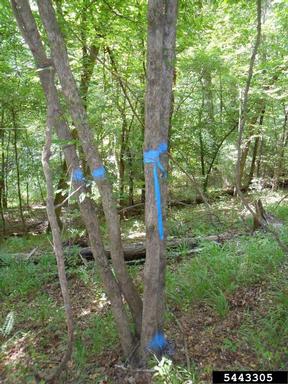
by Rick O'Connor | Aug 4, 2022
Author: Ian Stone – Forestry Extension Agent Walton County
Selecting a consulting forester is often a major decision for small to large private landowners engaged in forest management and enterprises. Consulting foresters provide technical forestry assistance in all aspects of forest management. These professionals can assist landowners by identifying goals and needs and then apply forestry expertise to meet these needs and goals. Consulting foresters are professionals who provide their services for a fee; much like lawyers or engineers. Consulting foresters provide multiple services with various fee structures which can be provided on an hourly, per acre, one-time, or percentage. For example, a herbicide treatment would often be on a per acre basis, while a timber sale would often be done on a percentage. A landowner should always have a consultant provide a scope of work along with the fee structure and estimate. It is advisable that a landowner consult several foresters or firms to compare services and fees before making a selection.

Streamside Management Zone (SMZ) marked prior to harvest so it is clear to the landowner and logger. This service is often performed by a consulting forester as part of timber sale preparation.
(Photo Credit: David Stevens, Bugwood.org Image# 5443305)
Consulting foresters are highly skilled professionals with extensive knowledge in many areas. Examples of required areas of knowledge are timber volume estimation and appraisal, forest management, tree planting and reforestation, prescribed fire, wildlife and habitat management, taxation, estate planning, forest treatment such as mechanical, herbicide, fertilization, and many more. Most consultants are well versed in all aspects of the forestry profession, but often have one or two areas of specialization. A landowner should discuss the services and credentials a forestry consultant or firm provides and select on that best fits their unique needs.
Many states require consulting foresters to become registered or certified through a professional certification board. Florida, however, is an exception to this which means landowners in Florida should thoroughly examine the forester’s professional credentials. Landowners should select a forester with the skills and credentials they require. The two largest professional organizations that set professional expectations for foresters are the Society of American Foresters (SAF) and the Association of Consulting Foresters (ACF) Examples of what to look for in credentialing are as follows:
- A 4-year bachelor’s degree in forestry or a related field; especially form an SAF accredited university forestry program
- Registration or certification in another state or nationally through the SAF Certified Forester
program
- Membership in professional forestry organizations such as ACF or SAF, along with similar
organizations such as Tree Farm, Florida Forestry Association, or Forest Landowners Association
- The ability to clearly communicate with the client and others. Ask for samples of contracts, a
written quote, an in-person meeting, and references from other landowners
- Professional integrity, honesty, and a commitment to ethical practice
Landowners can find listings of Consulting Foresters and firms in their area through multiple sources.
The Florida Forest Service (FFS) maintains an online list of consulting foresters through the FFS Vendor Database (Florida Forest Service Vendor Database (fdacs.gov)).
Landowners can find lists of registered foresters through the Alabama and Georgia boards of forestry. Most consultants close to state boundaries practice in multiple states. In addition, SAF and ACF maintain online listings of consulting foresters and members at large.
Additional Helpful Websites for Locating a Consulting Forester in the Panhandle-
Association of Consulting Foresters- Home (acf-foresters.org)
Alabama Board of Registered Foresters- ASBRF (alabama.gov)
Society of American Foresters- Find a Certified Professional (eforester.org)
References
Article adapted and paraphrased from:
Demers and Long, Selecting a Consulting Forester. Publication: SS-FOR-16 University of Florida-IFAS
Extension, EDIS
Alabama Board of Registered Foresters, Website-https://www.asbrf.alabama.gov/ Last Accessed
07/22/2022
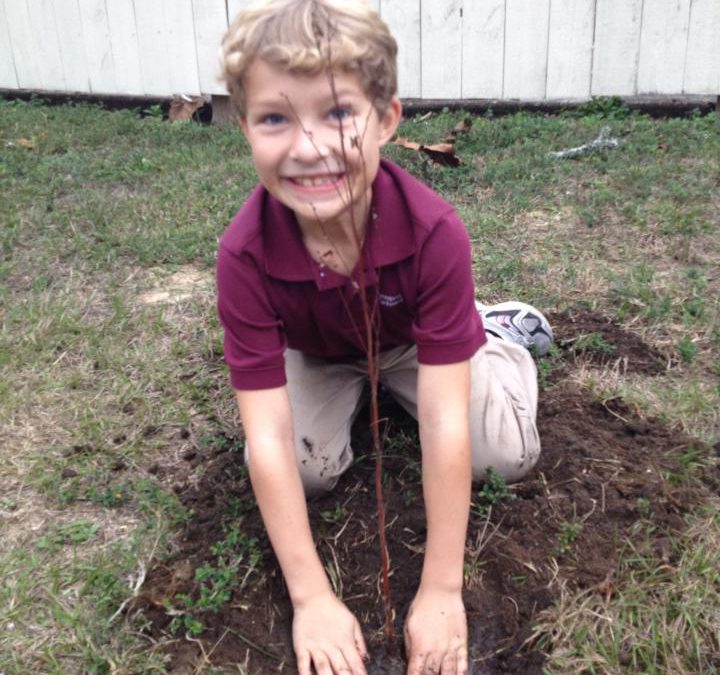
by Carrie Stevenson | Jan 20, 2022
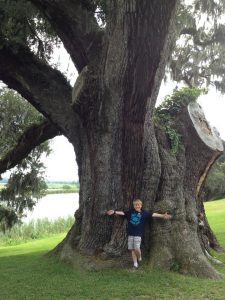
This giant heritage live oak tree has been providing oxygen, habitat, and shelter for 900 years! Photo credit: Carrie Stevenson, UF IFAS Extension
While many people think of planting trees in the spring, autumn and winter are ideal for these activities in Florida. The cooler weather means most trees are no longer actively growing and producing new leaves and fruit, so there are fewer demands on a newly planted tree to start “working” right away. The dormant winter season allows the trees to acclimate to their new environment and begin developing sturdy root systems.
However, a newly planted tree is only as valuable as the care it’s given when planted. To ensure a successful tree, important steps to follow include proper placement, planting depth, mulching, and watering.
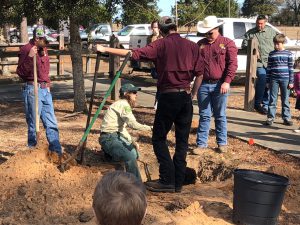
Proper tree planting practices can ensure a long-lived, healthy tree in the environment. Photo credit: Carrie Stevenson, UF IFAS Extension
Before digging, look up and around to make sure there are no overhead or underground obstacles within the reaches of the tree’s mature height or root system. When digging the planting hole, make sure the hole is 2-3 times as wide as the root ball. When planted, the topmost root flare (where the roots join the trunk) should be just above the surface of the adjacent landscape. It is not necessary to fertilize a newly planted tree. Use mulch to retain moisture in the soil, but do not place it against the tree’s trunk. Finally, water the tree daily, saturating the root ball, for 1-2 weeks then weekly for a year.
For more information on planting trees and good varieties of trees for Florida, visit this excellent resource from UF. As always, one should strive to plant the right tree in the right place. For those who live in suburban or urban areas, considerations like tree size, leaf shed, and water requirements are big concerns. For more information on size evaluation and plant selection, please visit this link from the UF Horticulture department.
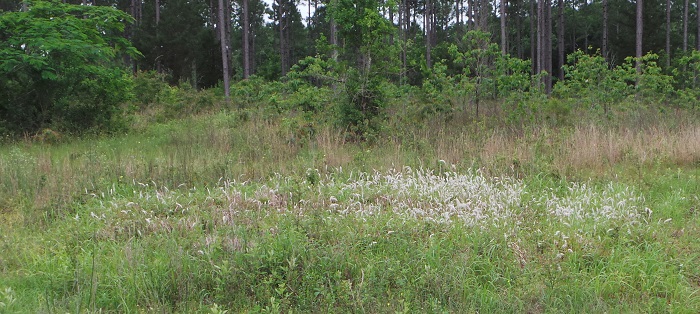
by Jennifer Bearden | Mar 26, 2021
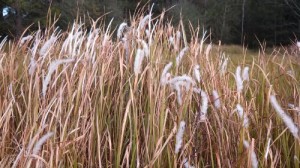
Cogongrass flowering
We’re waging war on an invasive weed, Cogongrass. Cogongrass was accidently brought into Mobile, Alabama in the early 1900’s as packing material. It was later planted in Florida and other states as a potential forage and soil stabilizer. It has low forage value and is on the Federal Noxious Weed List.
This weed can spread through both creeping rhizomes and seeds. It quickly displaces desirable grasses and plants. The roots of Cogongrass may produce allelopathic chemicals helping it out-compete other plants for space. It is drought and shade tolerant. A single plant can produce 3,000 seeds. Cogongrass is yellow/green in color with an off-set midrib and a fluffy white seed head and it grows in circular colonies.
Mowing and burning will not eradicate Cogongrass instead doing so while the plants are flowering can cause spread of seeds. Herbicide options are non-selective and kill most native ground cover such as grasses. Ridding an area of a Cogongrass infestation requires intensive management. For small infestations (less than 20-30 feet in diameter), treat the area with glyphosate once in the fall and once in the spring for 3 years (or until eradicated). For larger infestations, a more integrated approach may be necessary. Deep tilling of the soil may help in some cases.
Cogongrass is not easy to control. It takes a coordinated effort from government agencies and private landowners to work together to rid an area of this invasive weed. For more information, you can go to https://edis.ifas.ufl.edu/wg202 or contact your local extension agent.
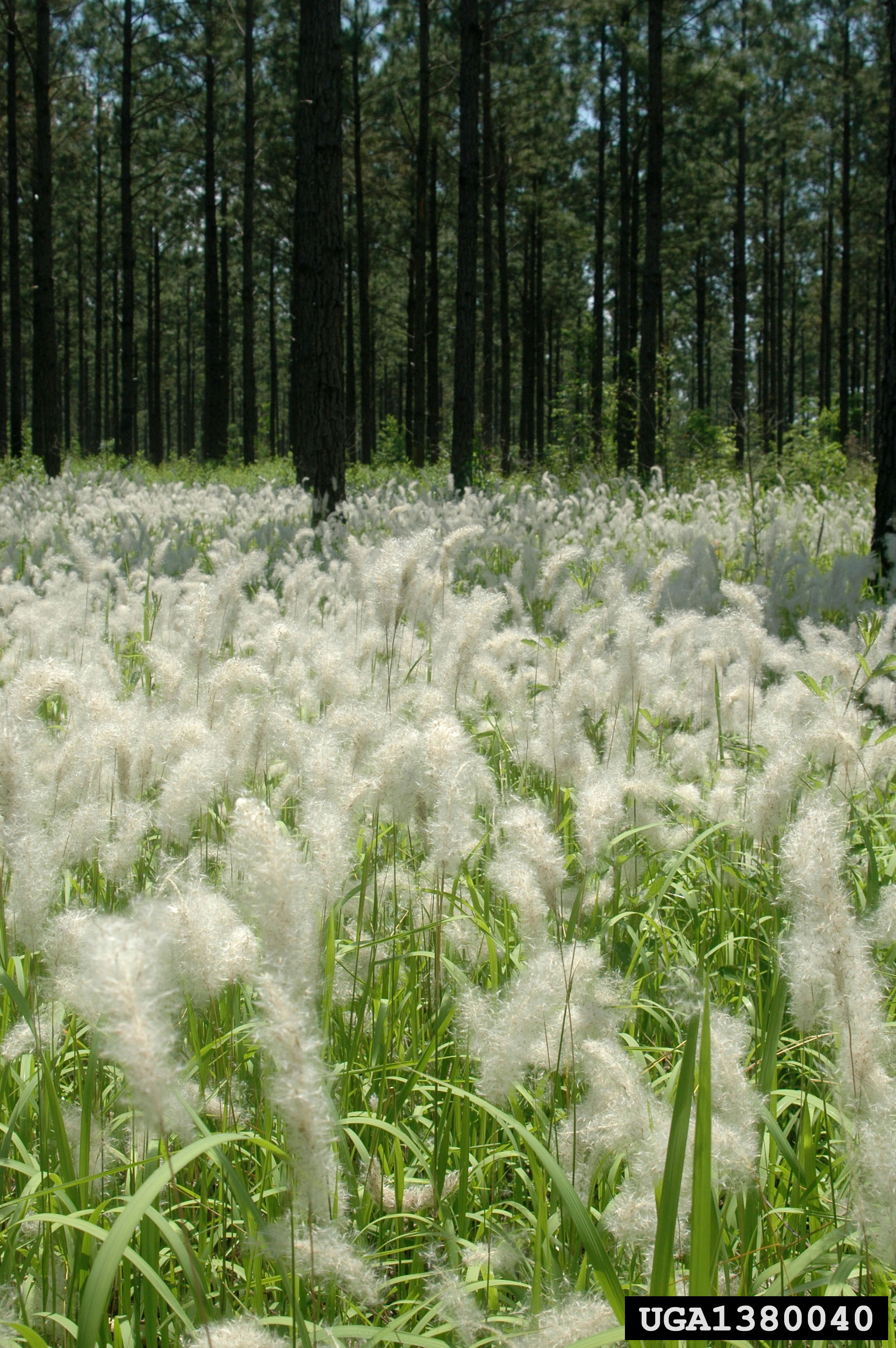
by Rick O'Connor | Mar 26, 2021
Six Rivers “Dirty Dozen” Invasive Species
Cogongrass (Imperata cylindrica)

A relatively new patch of cogongrass recently found in Washington County.
Photo Credit: Mark Mauldin
Define Invasive Species: must have all of the following –
- Is non-native to the area, in our case northwest Florida
- Introduced by humans, whether intentional or accidental
- Causing either an environmental or economic problem, possibly both
Define “Dirty Dozen” Species:
These are species that are well established within the CISMA and are considered, by members of the CISMA, to be one of the top 12 worst problems in our area.
Native Range:
Cogongrass is from southeast Asia.
Introduction:
It was accidentally introduced as an “escapee” from satsuma crates brought to Grand Bay, Alabama in 1912. It was later intentionally introduced into Mississippi in the 1920s as a forage crop and then to Florida in the 1930s for both forage and soil stabilization.
EDDMapS currently list 79,134 records of this plant. All are listed in the southeastern U.S. Most are in Florida and Alabama, but there are records from Mississippi, Louisiana, Texas, Georgia, North and South Carolina.
Within our CISMA there are 13,279 records. This is probably underreported.
Description:
Cogongrass is a perennial grass that can vary in color from a bright-light green when young to a brown-orange when older. It does die back in areas with cold winters and heavy frost and becomes brown. The leaves emerge from the ground in clumps and can reach four feet in height. The blades are 0.5-0.75 inches wide and the light-colored midline is off center. The blades are serrated along the edge. In the spring the grass produces large white colored fluffs of seeds extending above the leaves to be carried by the wind. There are numerous small seeds joined on long hairs of these structures. There is an extensive rhizome system beneath the ground that can contribute to short distance spread.
Issues and Impacts:
The plant spreads aggressively and has been found in ditches, along roadsides, in pastures, timberlands, golf courses, empty lots, and even on barrier islands. It spreads both by seed wind dispersal and rhizome fragmentation. The plant is known to be allelopathic, desiccating neighboring plants and moving in. It can form dense monocultures in many areas.
The serrated edges of the leaves make it undesirable as a livestock forage, a fact not detected until the plant was established. It can cover large areas of pasture making it unusable. In the winter the plant becomes brown and can burn very hot. Timberland that has been infested with cogongrass can burn too hot during prescribed burns actually killing the trees.
It is currently listed as one of the most invasive plants in the United States. It is a federal and state noxious weed, it is prohibited all across Florida and has a high invasion risk.
Management:
The key to controlling this plant is destroying the extensive rhizome system. Simple disking has been shown to be effective if you dig during the dry season, when the rhizomes can dry out, and if you disk deep enough to get all of the rhizomes. Though the rhizomes can be found as deep as four feet, most are within six inches and at least a six-inch disking is recommended.
Chemical treatments have had some success. Prometon (Pramitol), tebuthurion (Spike), and imazapyr have all had some success along roadsides and in ditches. However, the strength of these chemicals will impede new growth, or plantings of new plants, for up to six months. This can lead to erosion issues that are undesirable. Glyphosate has been somewhat successful, and its short soil life will allow the planting of new plants immediately. Due to this however, it may take multiple treatments over multiple years to keep cogongrass under control and it will kill other plants if sprayed during treatment.
Most recommend a mixture of burning, disking, and chemical treatment. Disking and burning should be conducted in the summer to remove thatch and all older and dead cogongrass. As new shoots emerge in late summer and early fall herbicides can then be used to kill the young plants. Studies and practice have found complete eradication is difficult. It is also recommended not to attempt any management while in seed (in spring). Tractors, mowers, etc. can collect the seeds and, when the mowers are moved to new locations, spread the problem. If all mowing/disking equipment can be cleaned after treatment – this is highly recommended.
For more information on this Dirty Dozen species, contact your local extension office.
References
Cogongrass, University of Florida IFAS Center for Aquatic and Invasive Plants
https://plants-archive.ifas.ufl.edu/plant-directory/imperata-cylindrica/
Imperata cylindrica. University of Florida IFAS Assessment.
https://assessment.ifas.ufl.edu/assessments/imperata-cylindrica/.
Early Detection and Distribution Mapping System (EDDMapS)
https://www.eddmaps.org/
Six Rivers CISMA
https://www.floridainvasives.org/sixrivers/
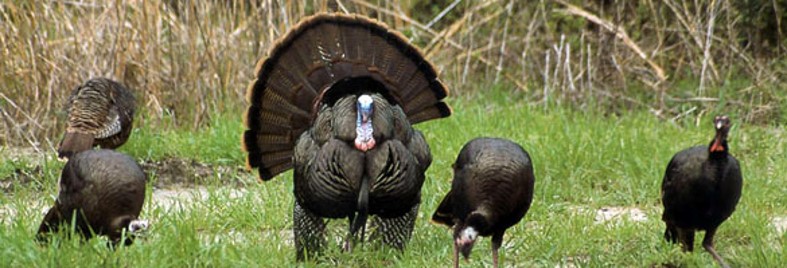
by Shep Eubanks | Mar 27, 2020

Wild Turkeys in Chufa planted in Gadsden County – Photo by Shep Eubanks UF IFAS
Wildlife management continues to be an area of growing interest on our local farms and ranches and has the potential to generate significant additional income to the farm enterprise. It is also an opportunity to practice good stewardship of the natural resources that we have in abundance here in the Panhandle. Each spring I get many phone calls from landowners wanting to know what they can plant to encourage wild turkeys to utilize their property more and to enhance the quality of their wild turkey habitat. Chufa is one such plant that wild turkeys love like most of us love ice cream and it is easy to grow and will provide feed for turkeys for several months.
What is chufa? Chufa is an African variety of the native nutsedge, which is a warm season perennial plant. However, chufa is not as aggressive as the native nutsedges and typically will not create problems with succeeding crops that you might plant after it. The actual foliage of the plant is not utilized by wildlife, but turkeys, hogs, ducks, and raccoons love the underground tubers that the plant produces. Each individual plant can produce 10 to 75 peanut kernel sized tubers (see photo 1) that wildlife utilize. These tubers are high in carbohydrates and protein, and they are also edible by humans, having a sweet taste similar to almonds or raw peanuts.
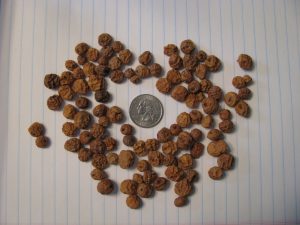
Photo 1. Chufa seed for planting – Photo by Shep Eubanks UF IFAS
Turkeys will usually begin to dig the chufas up in early fall as soon as the above ground leaves turn brown. In Florida, they will dig and eat the nuts from fall throughout the winter and into spring. (see photo 2 of turkeys feeding in a spring chufa patch)
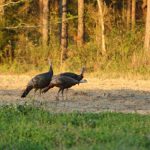
Photo 2. Turkeys scratching up chufas – Photo by Shep Eubanks UF IFAS
If you are considering planting chufa there are several considerations to take into account. The chufa plant typically grows well anywhere that field corn can be grown. You should soil test the area you intend to plant and lime to a pH between 6.0 – 6.5. On most soils this requires 1 ton of lime per acre. Recommended planting dates are April 1st through June 30th in the panhandle area. Earlier plantings will provide higher yields, whereas later plantings typically will provide foraging for wildlife later into the following spring. To maximize use by turkeys into the spring I would recommend looking at planting in June. Chufa can be planted later than June 30th some years but remember that it takes the plant approximately 90 days to produce mature tubers and this must be accomplished prior to frost/cold weather. Plant the seed into a well prepared and fertilized seedbed. The seeding rate for chufa is 40 – 50 pounds per acre broadcast or 30 pounds per acre drilled on a 36 inch row spacing. Strive for a coverage of 3 or 4 seed per square foot. When broadcasting the seed, set your disk to cut about 4 inches deep. This will cover the seed to an approximate depth of 2 inches which is ideal for chufa. Normal fertilizer recommendations would be 200 pounds of 17-17-17 per acre or equivalent at planting. When the plants are 6 – 12 inches high (approximately 1 month old) you should top dress with 100 pounds of actual N per acre (300 pounds of ammonium nitrate) to maximize yields. With high costs of fertilizer this may not be as desirable, but yields will be smaller if fertilizer rates are reduced. For weed control options on chufa plantings consult with your local County Extension Agent for up-to-date recommendations.
Small plantings are feasible (less than ¼ acre) if wild hogs are not present. It has been my experience that best results are obtained with ½ acre or larger plantings. Chufa is a plant that will do a good job of reseeding itself, sometimes for several years. Reseeding can be accomplished by simply disking the area of the previous planting between April and the end of June and following fertilizer recommendations for the initial planting. For most locations it is advisable to move the chufa plot to a different location after the second crop to avoid problems with soil pests. (see photo 3 of typical planting).
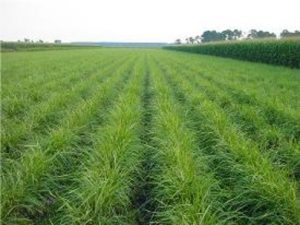
Photo 3. Chufa planting – Photo by Shep Eubanks UF IFAS
If you have never planted chufas before for your turkeys, you may want to pull some up or disk a row up in the fall after the tops have died back. This will assist the turkeys in finding the plants if they have never encountered it before. Once they do find it you can expect to find tremendous areas of scratching. Quite often the plots will literally look like a mortar or bombing range where the turkeys dig down to get the chufas!
For more information consult with your local Extension Agent .
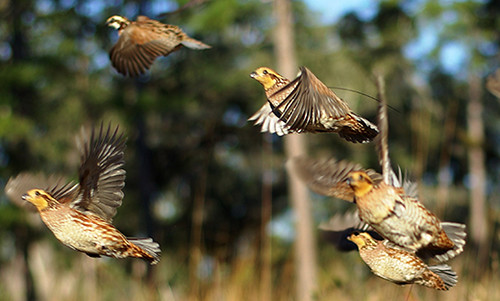
by Rick O'Connor | Dec 13, 2019
‘Bobwhites in Pine Savanna’ Workshop Set
For Jan. 30 in Marianna, Florida
The National Bobwhite Conservation Initiative (NBCI) and partners will host the Tri-State Bobwhite Symposium for professional land managers and landowners Thursday, January 30, 2020, in Marianna, FL.
It is the second Working Lands for Wildlife–Bobwhites in Pine Savanna workshop funded by the Natural Resources Conservation Service and is expected to draw attendees from three states. The program goal is to restore pine savanna on 82,000 acres across seven states using thinning, prescribed fire, and native grass restoration. Federal funding is available to landowners who choose to pursue pine savanna management on that designated landscape.
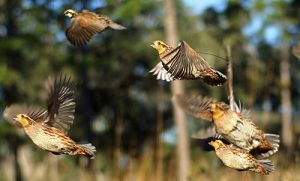
Bobwhite quail are popular with many hunters and management is trying to restore them.
Photo: USDA
“Private lands are a critical and necessary component for landscape-scale restoration of wild bobwhites, which is what NBCI is all about,” said NBCI Forestry Coordinator Steve Chapman. “Active management of pine forests on those lands, while still meeting landowner objectives, is a key NBCI strategy, and 82,000 managed acres will show the dividends of this approach.”
Dr. Jess McGuire, Quail Forever’s Working Lands for Wildlife bobwhite coordinator, added that “in order to achieve this level of restoration, wildlife professionals must be trained in the nuances of bobwhite management.”
The workshop will be from 9am–2pm at the University of Florida, Institute of Food and Agricultural Sciences (UF/IFAS) office, located at 2741 Penn Avenue, Suite 3, Marianna, FL 32448. Preregistration by January 23 is required by contacting jmcguire@quailforever.org or online at http://bit.ly/tristatequail.
Additional partners include Quail Forever, Florida Fish and Wildlife Conservation Commission, Tall Timbers Research Station and Land Conservancy, University of Florida Extension, and the Natural Resources Conservation Service.
Through multiple agreements, NBCI, in collaboration with Quail Forever and Warnell School of Forestry and Natural Resources/University of Georgia, will provide at least one of these workshops in each of the seven states identified in the project geography. Those states include Alabama, Florida, Georgia, New Jersey, North Carolina, South Carolina, and Virginia. Partners will also produce educational materials detailing management techniques and the results of intentional, targeted pine savanna management for bobwhites as part of the overall project.
About NBCI
Headquartered at the University of Tennessee’s Institute of Agriculture/Department of Forestry, Wildlife and Fisheries, NBCI is a science and habitat-based initiative of the National Bobwhite Technical Committee (NBTC) to elevate bobwhite quail recovery from an individual state-by-state proposition to a coordinated, range-wide leadership endeavor to restore wild bobwhites on a landscape scale. The committee is comprised of representatives of 25 state wildlife agencies, various academic research institutions and private conservation organizations. Support for NBCI is provided by the Federal Aid in Wildlife Restoration Program, state wildlife agencies, the Joe Crafton Family Endowment for Quail Initiatives, the University of Tennessee, Park Cities Quail and Roundstone Native Seed.
Contact:
John Doty
Communications Director
(865) 974-7281














